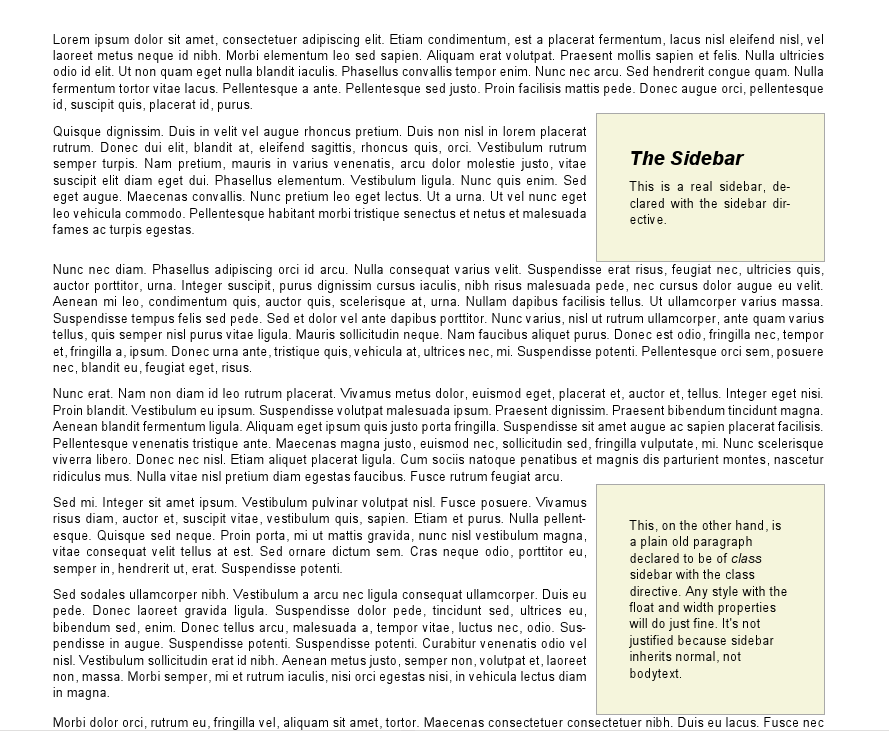Uqbar? Fail!.Rst2pf: Win!
So, I failed to release uqbar this week. However, I am releasing rst2pdf 0.8, with SVG support! Get its vectorial goodness from http://rst2pdf.googlecode.com
So, I failed to release uqbar this week. However, I am releasing rst2pdf 0.8, with SVG support! Get its vectorial goodness from http://rst2pdf.googlecode.com
I just committed into trunk of rst2pdf a nicely working SVGImage flowable for reportlabs.
The code is self-contained in two files:
You can use them in your app if you want (I'd like to know, though). One of them is GPL/LGPL (it's basically copied from uniconvertor) the other is MIT-Licensed.
The output is astonishing: svg.pdf is only 32KB and completely resolution-independent. Graphics in your PDF That look good printed and on screen! And are not huge! Yay!
This will be the flagship new feature in tomorrow's rst2pdf 0.8.
One of the big limitations of reportlab is that it has no support for vector-based images. You can't insert SVG, EPS or any other vector-based format in your documents.
Until now.
By hijacking another app called uniconvertor, I have managed to insert as vectors SVG images in a reportlab document.
Here's the hackish code:
import sys,os from app.io import load from app.plugins import plugins import app from reportlab.platypus import * from reportlab.lib.styles import getSampleStyleSheet from reportlab.lib.units import inch app.init_lib() plugins.load_plugin_configuration() class SVGImage(Flowable): def __init__(self,imgname): self.doc = load.load_drawing(imgname) for k in dir(self.doc): print k self.saver = plugins.find_export_plugin(plugins.guess_export_plugin(".pdf")) Flowable.__init__(self) def wrap(self,aW,aH): br=self.doc.BoundingRect() return br[2],br[3] def drawOn(self,canv,x,y,_sW=0): canv.translate(x,y) self.saver (self.doc,".ignoreme.pdf",options={'pdfgen_canvas':canv}) os.unlink(".ignoreme.pdf") styles = getSampleStyleSheet() def go(): doc = SimpleDocTemplate("phello.pdf") Story = [Spacer(1,2*inch)] style = styles["Normal"] p = SVGImage('warning.svg') Story.append(p) doc.build(Story) go()
It has several problems (see where the second paragraph ended), but it does work.
To run it, you need a warning.svg file (edit as needed) and you run it this way (replacing the path as proper for your setup):
PYTHONPATH=/usr/lib/python2.5/site-packages/uniconvertor/ python use_uniconv.py
In fact, this is not limited to SVG files. You should be able to use the following formats:
CorelDRAW ver.7-X3,X4 (CDR/CDT/CCX/CDRX/CMX)
Adobe Illustrator up to 9 ver. (AI postscript based)
Postscript (PS)
Encapsulated Postscript (EPS)
Computer Graphics Metafile (CGM)
Windows Metafile (WMF)
XFIG
Scalable Vector Graphics (SVG)
Skencil/Sketch/sK1 (SK and SK1)
Acorn Draw (AFF)
Right on schedule, everything I promised, plus much simpler/smarter font embedding, and maybe a bag of chips. More at http://rst2pdf.googlecode.com.
Keeping with my new time-based release schedule, tomorrow is again rst2pdf release day! What will be new in 0.7? Several things!
Fixed several serious bugs, specially with the handling of literal blocks (preformatteds and code blocks).
Implemented a rather neat sidebar/floating block mechanism. It only lets you go float-left or float-right but it looks better than what you get in HTML, at least:

You can even use it to float almost arbitrary objects, so you can have floating images or floating figures.
Fixed the look of hyperlinks. Reportlab had a bug about making some hyperlinks underlined, and those with a black thick underline. Not when you use rst2pdf! Monkey-patched the heck out of that.
Table styling. Let me show you:

The first row is a header row. It automatically takes the table-heading style.
The following rows are regular, and they take the table style, which has support for zebra tables with alternating colors (white and gray here).
The lone red cell at the right is special. Its content is this:
.. class:: red red
If you don't know ReST, that means "red" is a paragraph with class red, so it will be styled whatever way that means (here: red background).
Usually that would mean you have a white (or gray) cell with a red paragraph in it. That looks incredibly ugly.
So, rst2pdf tries to be clever: If there is a single element in a cell, it will try to guess the cell background from it.
And as you saw above, it works :-)